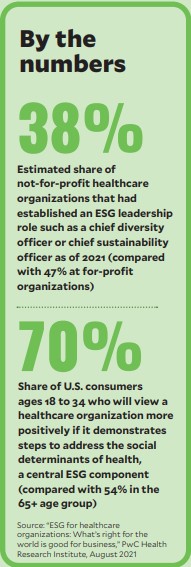Bringing ESG principles to healthcare
Hospital finance teams are adapting to a scenario in which bond issuers and credit-rating agencies take more interest in environmental, social and governance (ESG) issues.
Hospitals and health systems that don’t prioritize environmental sustainability arguably fail to do right by their communities, but more and more also may face a problem of greater short-term urgency.
Namely, their access to capital could be constrained as the investor community looks to apply ESG principles to assessments of risks and opportunities.
“I just don’t see this not becoming a part of [the industry’s] DNA going forward,” said Kevin Holloran, senior director and sector leader of the Not-for-Profit Healthcare Group at Fitch Ratings, and a member of HFMA’s Principles & Practices Board.

The Securities and Exchange Commission in recent years has made ESG a focal point of its oversight of publicly traded companies, and that emphasis is trickling down to the not-for-profit healthcare space.
Also in that space, the increased issuance of taxable debt has led to questions about ESG, Holloran said: “That got a lot of the bond agencies and the issuers [wondering], ‘What do we need to be saying about this?’”
Another driver is the higher interest in ESG among today’s workforce, especially younger professionals.
“When I got out of college, I didn’t know about it,” the 52-year-old Holloran said.
His two daughters’ generation is more likely to think about ESG when it comes time to select an employer, he added. That means HR departments at hospitals are starting to take a keener interest in the topic.
As are finance leaders.
“I probably had 30 discussions about ESG with my own finance team in the last 18 months, which is far more than I had in the time before that,” said Jon Utech, senior director of Cleveland Clinic’s Office for a Healthy Environment, who joined the organization in 2013. “It’s because bond investors are asking about our carbon footprint, where can they find the information, and other aspects of our sustainability performance.”
Holloran has not seen a difference in pricing between standard bonds and green bonds, which are funding instruments designed for climate and environmental projects.
“The sample size is very small,” he said.
With interest rates surging, however, he can foresee ESG becoming “more of a differentiator in pricing.” Bond documents eventually could include fields that assess ESG initiatives, such as efforts to make buildings greener.
A need for transparency
The industry has a long way to go to produce the type of transparent disclosures that are necessary to drive large-scale improvements in ESG, said Emily Senay, MD, MPH, a lecturer on sustainability issues at Yale University. Her ideal scenario includes mandatory reporting on a specified set of ESG measures, potentially linked to reimbursement in the way that reporting on clinical quality is required for hospitals to earn the maximum Medicare payment.
Recognizing the ongoing shift, Fitch recently developed ESG relevancy scores, which can be highlighted in reports to help investors understand the impact of ESG practices on financial metrics and, ultimately, on ratings.
The scores offer a view into an organization’s practices but don’t directly affect ratings. Such a correlation would almost be redundant, Holloran said, since ESG has a direct impact on performance and thus already is accounted for in ratings.
“If you’re doing a good job of governance, doing a good job with ESG, a good job with DEI [diversity, equity and inclusion], you’re going to see that reflected in your margins and eventually everything else — your balance sheets, your ability to recruit,” he said.
Yet as the issues become more prominent in policy and investing circles, Holloran can envision a day when hospitals and health systems receive a separate ESG rating.
For now, significant deviations in ESG relevancy scores are rare among not-for-profit healthcare organizations, Holloran said. Furthermore, in a sign that hospitals operate with at least a baseline level of environmental responsibility, the “E” issues usually don’t resonate in the scores compared with social and governance concerns such as labor relations, financial transparency and board effectiveness.
Key accounting concerns
“ESG is a sustainability accounting revolution,” Senay said.
The revolution is in a nascent stage, however. There’s still no common language for ESG reporting even among the three major rating agencies, Holloran said, much less among investors and bond issuers.
“What I might call employee well-being someone else might call employee recruitment and retention,” he said. “It causes a lot of confusion in the marketplace. Over time, I think we’ll all collectively get better on the whole thing.”
Organizations may have to tweak roles and make new hires, Holloran noted. Education may have to evolve, such as by offering a CPA certification that specializes in ESG. Brainstorming will be needed to capture insights such as the link between a green building and improved recruiting.

Reporting opportunities
Senay hopes to see ESG incorporated in community benefit reporting. The format would be a way for hospitals to showcase not only the steps they are taking to reduce their carbon footprint, but also the positive health impact they make through, for example, building green spaces.
Such disclosure would not be anything new for Cleveland Clinic, which has been including ESG assessments in its annual sustainability report since 2013.
“It helps integrate all this information as more of a strategic focus,” Utech said. “Hospital systems are so busy. They do lots of things, and people don’t always talk to each other.”
The ESG process fosters systemwide communication.
“There’s a sort of acceleration of the work of the organization,” Utech added, “just by going through this and sharing stories, and becoming clear about how this work aligns with the organization’s overall strategy.”





